Intercomparison of Solid Precipitation Derived from the Weighting Rain Gauge and Optical Instruments in the Interior Qinghai-Tibetan Plateau
Abstract
Due to the light precipitation and strong wind in the cold season, it is hard to get credible solid precipitation on the Qinghai-Tibetan plateau (QTP). To address this issue, two kinds of optical instruments, the Thies Laser Precipitation Monitor (LPM) and OTT laser-optical Particle Size Velocity (Parsivel), were used on QTP. The measured precipitation was compared with the precipitation derived from Geonor T-200B precipitation gauge (Geonor). The results showed that Geonor was hard to catch light precipitation (precipitation amount was less than 1 mm during a single event) when the wind speeds were higher than 3.5 m/s. Even when the wind speeds were smaller than 3.5 m/s, about 44% of such light precipitation events were not recorded by Geonor. The optical instruments had much better performance in recording light precipitation. Three methods were used to correct Geonor measurements of daily solid precipitation and the corrected values were set as reference for assessing the performance of LPM and Parsivel; the results showed that LPM had good performance in measuring the solid precipitation but Parsivel overestimated the precipitation amount. Methods for correcting Geonor’s hourly solid precipitation and recalculating Parsivel’s solid precipitation amount were also proposed in this paper.
1. Introduction
Accurate precipitation is important for better understanding the climate change and water cycle [1–4], and it is also a crucial component of hydrologic and climatologic models [4–6]. Currently, the precipitation is mainly measured by different kinds of rain gauges; however, it is generally recognized that the gauge-measured precipitation has systematic errors including wetting, evaporation losses, and wind-induced undercatch [7–9]. Especially the solid precipitation, the measurement errors frequently range from 20% to 50% due to undercatch in windy conditions [10]. In order to get the true solid precipitation, the World Meteorological Organization (WMO) carried out a series of programs. In the third WMO precipitation measurement intercomparison (1986–1993), the Double Fence International Reference (DFIR) with a shielded Tretyakov gauge was designated as the reference standard snow gauges [11]. Since 2012, the WMO Commission for Instruments and Methods of Observation organized the Solid Precipitation Intercomparison Experiment (SPICE); the main objectives of the project are to define and validate the field references for gauge intercomparison and to assess the automatic systems used in the operational networks for solid precipitation observations [12]. Under these projects, the gauge undercatch of solid precipitation had greatly improved in most areas of the global. In China, Ye et al. [13] corrected the precipitation data over China and reported an approximately 16% increase in mean yearly precipitation during 1951–2004. Ding et al. [14] compared the measured and corrected precipitation data over China during 1951–1998 and found that bias corrections of precipitation lead to an 8% overall enhancement of yearly precipitation trends over China. Ma et al. [15] corrected the precipitation data by using different kinds of error correction procedures in the Third Pole Environment (TPE) region and found that the average annual precipitation has increased from a minimum of 4 mm to a maximum of 409 mm in this region. However, no special attention had been paid on the solid precipitation correction in the interior QTP until now [16].
QTP is known for its large sensible and latent heating effects on the troposphere over Asia. Quantitative evaluation of area precipitation is one of the important aspects for estimating latent heating and understanding the water cycle processes over this unique highland [17]. Compared with the other regions, the climate in the interior of QTP is special; the wind is strong and the light precipitation is dominant in winter, and the manual observation is unrealistic during this period due to the severe weather conditions, so it is nearly impossible to obtain the light solid precipitation from the traditional rain gauges.
Sugiura et al. [8] first introduced a snow particle counter (SPC) to solid precipitation measurement and proposed that the optical instruments like SPC should be used in solid precipitation measurements in the Arctic. Compared with SPC, LPM and Parsivel are kinds of more mature optical products and were well tested in liquid precipitation measurements before [18–21]. Furthermore, both of LPM and Parsivel had been used by the WMO for solid precipitation measurement in the SPICE project. Because LPM and Parsivel use the light beam for precipitation monitoring, the wind-induced precipitation will be much smaller. Furthermore, the minimum precipitation intensity derived from the LPM and Parsivel is 0.005 mm/h and 0.001 mm/h, respectively; it seems that the optical instruments will be most suitable for solid precipitation measurement in the interior QTB. However, no attention had been paid to whether they can be used for the solid precipitation observation in these regions until now.
In this study, we analyzed solid precipitation derived from Geonor and two kinds of optical instruments (Parsivel and LPM) at three meteorological stations in the Beiluhe (BLH), Tanggula (TGL), and Wudaoliang (WDL) lie in the interior QTP. Considering the old version of Parsivel has large error when measuring snow [22], the two Parsivel instruments used in this study are the latest version (Parsivel2). Our goals are (1) investigating Geonor’s deficiency in recording the light solid precipitation and (2) assessing the performance of optical instruments in measuring the solid precipitation in the interior QTP. Finally, we hope to get the more reliable solid precipitation data in these regions.
The paper is organized as follows. Section 2 introduces the basic conditions and the instruments in the study sites; the correcting methods for Geonor’s daily solid precipitation are also introduced in this section. Section 3 compares the solid precipitation derived from the different instruments and the performance of Geonor in recording light precipitation is also discussed in this section. In Section 4, a statistic method for determining Parsivel’s snow particles diameter correction factor (α) is proposed and the Parsivel solid precipitation amounts are recalculated. The discussions and conclusions are in Section 5.
2. Methodology
2.1. Study Sites
The observation stations chosen in this study are Beiluhe (BLH; 92.9°E, 34.8°N, 4600 m above sea level), Tanggula (TGL; 91.9°E, 33.1°N, 5100 m above sea level), and Wudaoliang (WDL; 93.1°E, 35.2°N, 4783 m above sea level). All of the three stations are located in the interior QTP (Figure 1). Based on previous observations, the mean annual air temperature (MAAT) in BLH is −3.8°C, with the highest value of 21.3°C in mid-July and lowest value of −21.4°C in later January [23, 24]. In TGL station, the MAAT is about −4.1°C and its highest and lowest values are 16.2°C and −30.5°C [25]. The MAAT in WDL is about −5.1°C and maximum and minimum air temperature are 20.1°C and −26.5°C [26]. The mean annual precipitation in the three stations are 368 mm, 436.7 mm, and 294.8 mm, respectively [26, 27]. Due to the summer monsoon generally occurring from May to October, the precipitation events on the QTP mainly occur during the period from June to September. Like most areas on the QTP, the cold season of the three stations is long and the wind speeds during this periods are large, the instantaneous wind speed can reach to larger than 15 m/s.
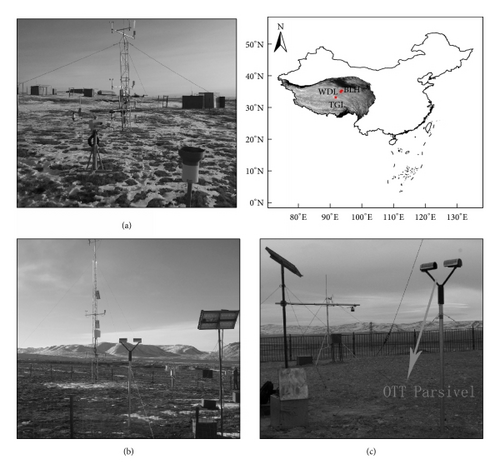
In the three stations, the routine meteorological parameters like wind (2 m, 5 m, and 10 m), air temperature (2 m, 5 m, and 10 m), humidity (2 m, 5 m, and 10 m), precipitation, and solar radiation had been monitored since the early 21st century. The rain gauge used in the TGL and WDL stations is Geonor, but in the BLH station is TE525 tipping-bucket rain gauge. In order to get the more detailed and accurate precipitation information, a LPM and a Geonor precipitation gauge were set in the BLH station in 2011 and 2012 separately. In the end of 2014, two Parsivel instruments had been installed in the TGL and WDL stations. In this study, the Geonor precipitation data were recorded every one hour in BLH station and every 30 minutes in TGL and WDL stations. In order to understand the microscopic information of the precipitation, the LPM and Parsivel data were recorded every minute. All of the data were logged by the CR23X or CR3000 data logger (Campbell Scientific Inc.).
2.2. Introduction of Instruments
The LPM uses the light beam for precipitation monitoring. Every time when precipitation particles pass through the sensing volume, it is capable of measuring their diameter and falling velocity [20]. From these measurements, it identifies the type of precipitation and calculates precipitation rate, drop-size distribution, and some other parameters. Bloemink and Lanzinger [18] compared the precipitation type derived from LPM with the Vaisala FD12P Present Weather Sensor and proposed the LPM can identify the precipitation accurately.
OTT Parsivel is also a laser-based optical disdrometer for simultaneously measuring the size and velocity of all types of hydrometeors during precipitation [21]. Its operating principle is similar to LPM, and the measurement area is 54 cm2, a little larger than LPM. The sensor determines the size and velocity of a hydrometeor by measuring the light extinction caused by the hydrometeor falling through the light sheet. The hydrometeor is then classified into 32 classes of sizes and velocity. From the size and velocity distribution information over the measurement period, the precipitation type, rate, and amount are determined.
Geonor is an automated weighing storage gauge which is widely used in the interior QTP. It continuously measures the weight of accumulated snowfall in a reservoir containing antifreeze solution and oil which melt the snow and reduce evaporation. The reservoir is suspended on a wire strain gauge which vibrates at a frequency proportional to the applied strain. The reservoir and strain gauge are in a protective housing which is surrounded by the Alter-shield. The Geonor has a resolution of 0.1 mm SWE and an accuracy of 0.1% [28].
2.3. Methods for Correcting Geonor Solid Precipitation
Equation (1) was proposed by Smith and (2) was by MacDonald and Pomeroy. Both of the two methods had been widely used and proven effective in improving the hydrological simulation [31–36].
3. Results
3.1. Overview of Data
In the BLH station, observations were carried out from 2011/11/11 to 2012/4/30 and from 2012/11/1 to 2013/5/16. During the first period, the Geonor precipitation gauge was not installed in the BLH site; Geonor precipitation data were obtained from a meteorological station nearby (set by the State Key Laboratory of Frozen Soil Engineering, Cold and Arid Regions Environmental and Engineering Research Institute, Chinese Academy of Sciences, less than 1 km far from our site). During the second period, 33 days were not observed for the power supply reason. In TGL and WDL stations, the Parsivel instruments worked very well after installation and the data were collected every two months; the data of the two stations used in this study were from 2014/10/1 to 2015/4/30 and from 2014/10/1 to 2015/2/3, respectively. During the study periods, the winds were strong and the instantaneous wind speed can reach to larger than 10 m/s in BLH and 16 m/s in TGL (Figure 2). Due to the high frequency light precipitation and the strong wind, processing solid precipitation data from Geonor precipitation gauge was also hard work. In this study, we processed the data carefully and used the optical instruments data as the standard for the judgment of precipitation events.

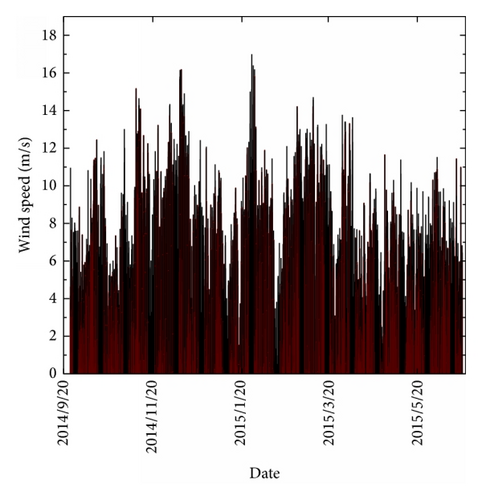
During the study periods, the precipitation days recorded by Geonor and the optical instruments were different (Figure 3). In the BLH station, LPM recorded 79 and 47 precipitation days during the two periods, but Geonor only recorded 31 and 27 precipitation days. In the TGL station, the precipitation days were 45 and 80 recorded by Geonor and Parsivel, respectively. In the WDL station, Parsivel recorded 41 while Geonor only recorded 18 precipitation days. In order to find which instrument was more credible, we chose a precipitation event during 2014/11/2 in TGL station (Figure 4); the Parsivel recorded 4.44 mm precipitation while the Geonor recorded no precipitation. By comparing the radiation and albedo with the before and the proceeding day, we found that both the global and net radiation decreased on November 2, and the albedo increased in the afternoon. The results showed that it was a precipitation day on 2014/11/2. This indicates that the optical instruments can record light precipitation that cannot be recorded by the Geonor.
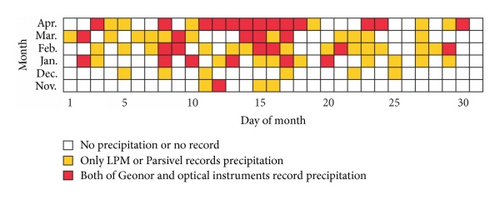
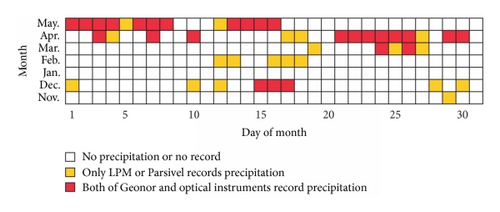
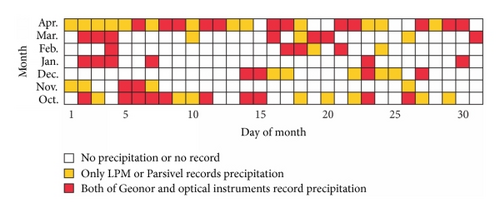
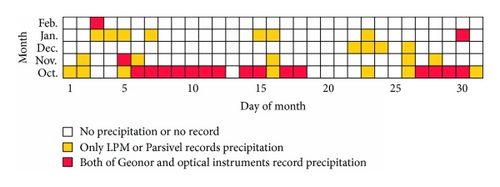
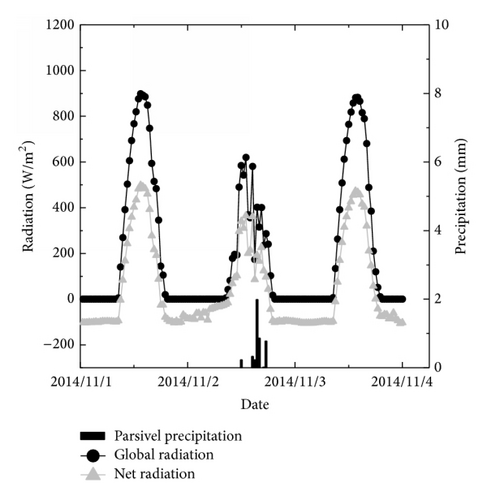
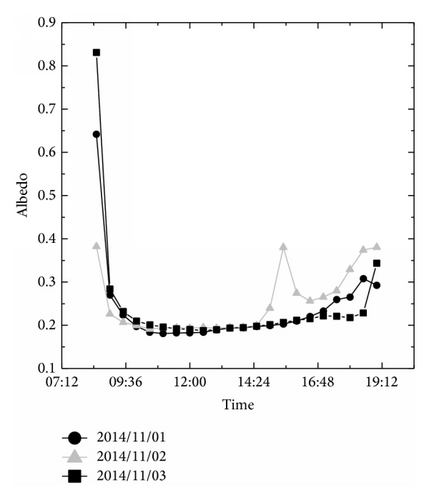
3.2. Comparison of the Daily Solid Precipitation
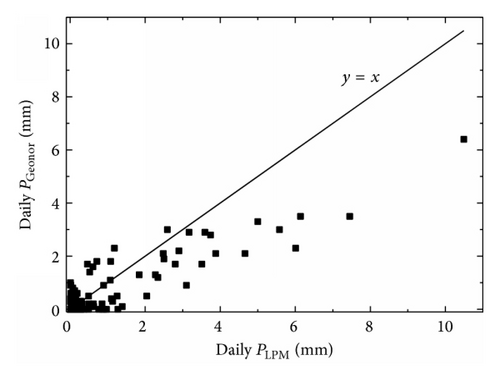
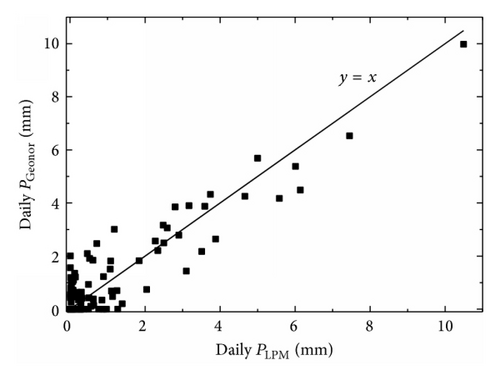
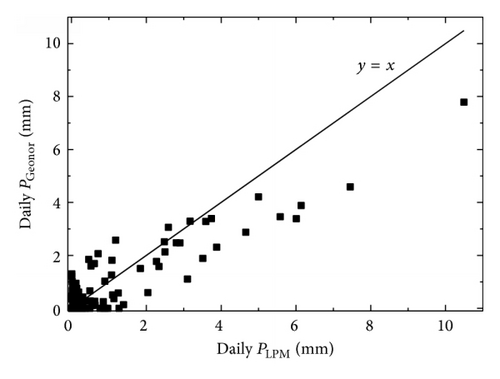
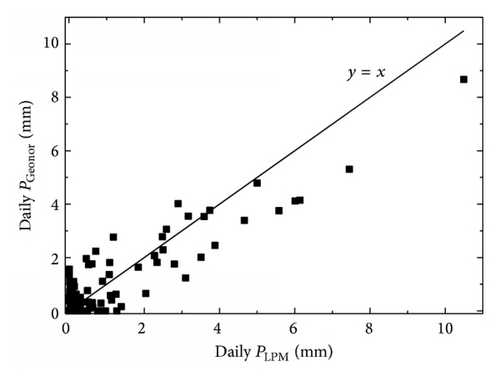
The scattergram of daily corrected Geonor precipitation (Pc-Geonor) and precipitation recorded by Parsivel (PParsivel) in TGL station were shown in Figure 6; the daily Pc-Geonor by the three correction methods were still much smaller than PParsivel. Furthermore, the precipitation amount during 2014/10/1 and 2015/4/30 in TGL station recorded by Parsivel was 305 mm; this disagrees with the reality of the interior QTP. Therefore, we proposed that the Parsivel overestimated the solid precipitation in these regions. Boudala et al. [40] compared the solid precipitation rate and the total precipitation derived from three instruments (Pluvio, Parsivel, and PD12P) on Whistler Mountain in Canada and also proposed that the Parsivel overestimated the solid precipitation, which is consistent with the conclusion in our study.
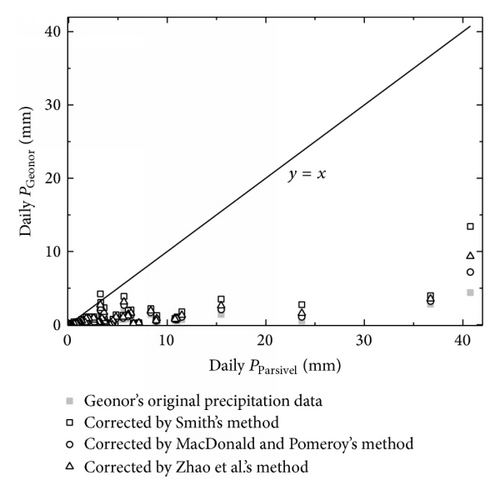
3.3. Assessing Geonor’s Deficiency in Recording Light Solid Precipitation
The precipitation gauge includes the DFIR which cannot detect the light solid precipitation under the wind conditions [8]. In this section, Geonor’s deficiency in recording light solid precipitation in the interior QTP had also been investigated. 75 precipitation events at different precipitation amount and wind speed recorded by LPM were used for finding the light precipitation threshold that can be detected by the Geonor. It can be seen from Figure 7 that when the wind speeds (WS) were larger than 3.5 m/s, the Geonor nearly could not record the precipitation events when the amount was smaller than 1 mm. Even when 0.5 < WS < 3.5 m/s, about 44% of these light precipitation still could not be recorded by Geonor.
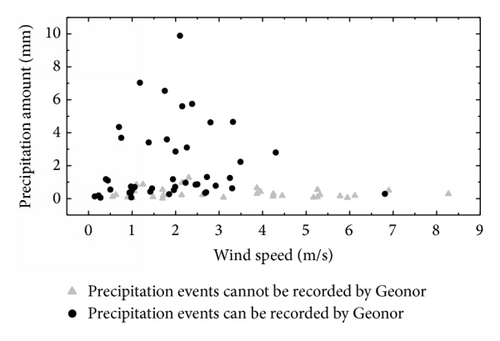
3.4. Correcting Geonor’s Hourly Solid Precipitation
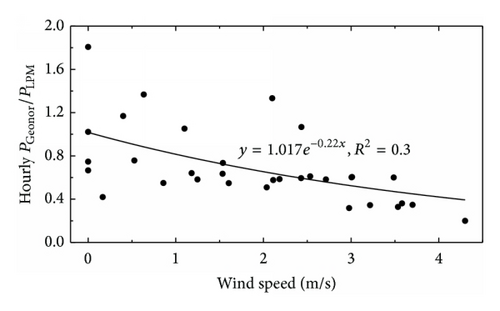
The regression is statistically significance with F value = 96.8 and α < 0.01 by using the F test. However, it is important to note that the data are scattered. One possible explanation is that the frequency of light precipitation is high in these regions; the Geonor has large system errors when recording the light precipitation.
4. New Method for Calculating the Parsivel Solid Precipitation Amount
4.1. Determination of Snow Particles Diameter Correction Factor (α)
- (1)
Equation (7) was used for correction of Geonor’s half-hour solid precipitation with small wind speed and setting the corrected precipitation amount (Pc-Geonor) as the “true” value.
- (2)
Choose the corresponding snow particle information and use (8) for calculation. Considering the small particles (D < 1 mm) are mainly single grain and the larger particles (D > 1 mm) are mainly granular aggregate based on the field observation, the calculation was divided into two parts as follows:
()where αD<1 is the snow particles diameter correction factor when D < 1 mm and αD>1 is the correction factor when D > 1 mm. The meaning of other parameters was the same with (8). - (3)
The least square method was used to calculate αD<1 and αD>1.
Based on the above method, 81 samples with wind speed smaller than 3 m/s in TGL station were chosen to determine α in the interior QTP, and the results were αD<1 = 0.72 and αD>1 = 0.3446.
4.2. Recalculation of Monthly and Daily Solid Precipitation in TGL Station
Based on (8), the monthly solid precipitation derived from Parsivel was recalculated. In the WDL station, the routine meteorological data were missing during the study periods; we only compared recalculated Parsivel’s monthly precipitation with Geonor’s corrected precipitation in TGL station; the results were shown in Figure 9. During the study periods, the total precipitation amount recorded by Geonor is 29.4 mm, and Geonor’s total precipitation had increased to 66.5 mm after correction. After recalculation, Parsivel’s total precipitation was 66 mm during this period, which was nearly equal to the corrected Geonor’s. It was important to note that there were still differences between the recalculated Parsivel (Pr-Parsivel) and the corrected Geonor (Pc-Geonor) at monthly scale, especially when the monthly precipitation was small, and the differences were larger. This was also related with Geonor’s bad performance in recording light precipitation.

The recalculated daily solid precipitation of Parsivel (Pr-Parsivel) was also compared with the corrected Geonor (Pc-Geonor) by (7); the results were shown in Figure 10. By using the new calculation method, the Pr-Parsivel value was close to Pc-Geonor based on the method proposed in this study. That means that the new calculation method is suitable for recalculating Parsivel’s solid precipitation in the interior QTP.
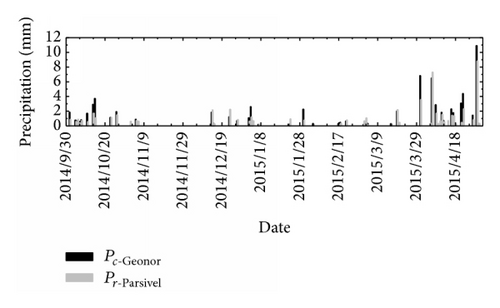
5. Discussions and Conclusions
By comparing the solid precipitation amount derived from the Geonor precipitation gauge with LPM and Parsivel in the three meteorological stations in the interior QTP. We came to the conclusions that the Geonor nearly could not catch the light precipitation (the precipitation amount is less than 1 mm during a event) when the wind speed was larger than 3.5 m/s. Even when the wind speed was smaller than 3.5 m/s, about 44% of that light precipitation event still could not be recorded by Geonor. However, the light precipitation is dominant and the wind is strong in winter in the interior QTP. According to our statistics, based on the LPM data in the BLH station, the light precipitation events (the precipitation amount is less than 1 mm during a event) accounted for more than 75% of the total precipitation events in the cold season. So the challenges for getting accurate solid precipitation in the interior QTP are not only correcting the precipitation gauge’s catch efficiency, but also catching the light precipitation in these regions.
LPM and Parsivel could detect light solid precipitation that remains and could not detected by Geonor and some other traditional precipitation gauges. By comparing the daily solid precipitation derived from LPM and Parsivel with the corrected Geonor precipitation, we found that LPM can record credible solid precipitation in the interior QTP. However, Parsivel overestimated the precipitation amount. Finally, we concluded that LPM can be effectively conducted in the interior QTP. Taking the LPM’s solid precipitation as the reference value, we also proposed a method for correcting Geonor’s solid precipitation at the hourly scale.
In order to get the credible solid precipitation from Parsivel, a new precipitation calculation formula by just using the size and number of snow particles had been proposed in this study, and the diameter correction factor of snow particles was determined by the statistical method. By using the new calculation formula, the accuracy of solid precipitation amount derived form Parsivel had been improved.
In summary, the optical instruments have large potential in recording more accurate solid precipitation and they are also powerful tools for recording the high frequency light precipitation in the interior QTP. However, it should be mentioned that both LPM and Parsivel have large errors when used for measuring mixed precipitation. Further efforts need to be made next.
Conflict of Interests
The authors declare that there is no conflict of interests regarding the publication of this paper.
Acknowledgments
This research was supported by Key Project of Nation Natural Science Foundation of China (2013CBA01803), the National Natural Science Foundation of China (41271081 and 41271086), the Youth Science Fund of China (41401085), the Hundred Talents Program of Chinese Academy of Sciences (51Y551831), and the Key Deployment Project of Chinese Academy of Sciences (KJZD-EW-G03-02).




